University of Greenwich: Measurement of VO2max Lab Report Analysis
VerifiedAdded on 2023/01/17
|10
|2490
|26
Report
AI Summary
This lab report details an experiment to measure maximal oxygen consumption (VO2max), a key indicator of cardiopulmonary and muscle oxidative function. The report includes an introduction to VO2max, its significance in clinical and sports research, and the criteria for a valid test based on BASES guidelines. The methodology section describes cycle ergometer and treadmill protocols, including data collection of expired air samples, heart rate, and RPE. Results are presented in a table, detailing participant data such as VO2max, power output, and respiratory exchange ratio. The discussion section analyzes individual participant results, comparing them to BASES guidelines and literature values, and includes a scatter plot of age against VO2max. The report concludes with an assessment of the experiment's success, acknowledging potential sources of error and emphasizing the understanding of VO2max determination procedures. The average VO2max for the participants was found to be 43.80 ml/kg/min.
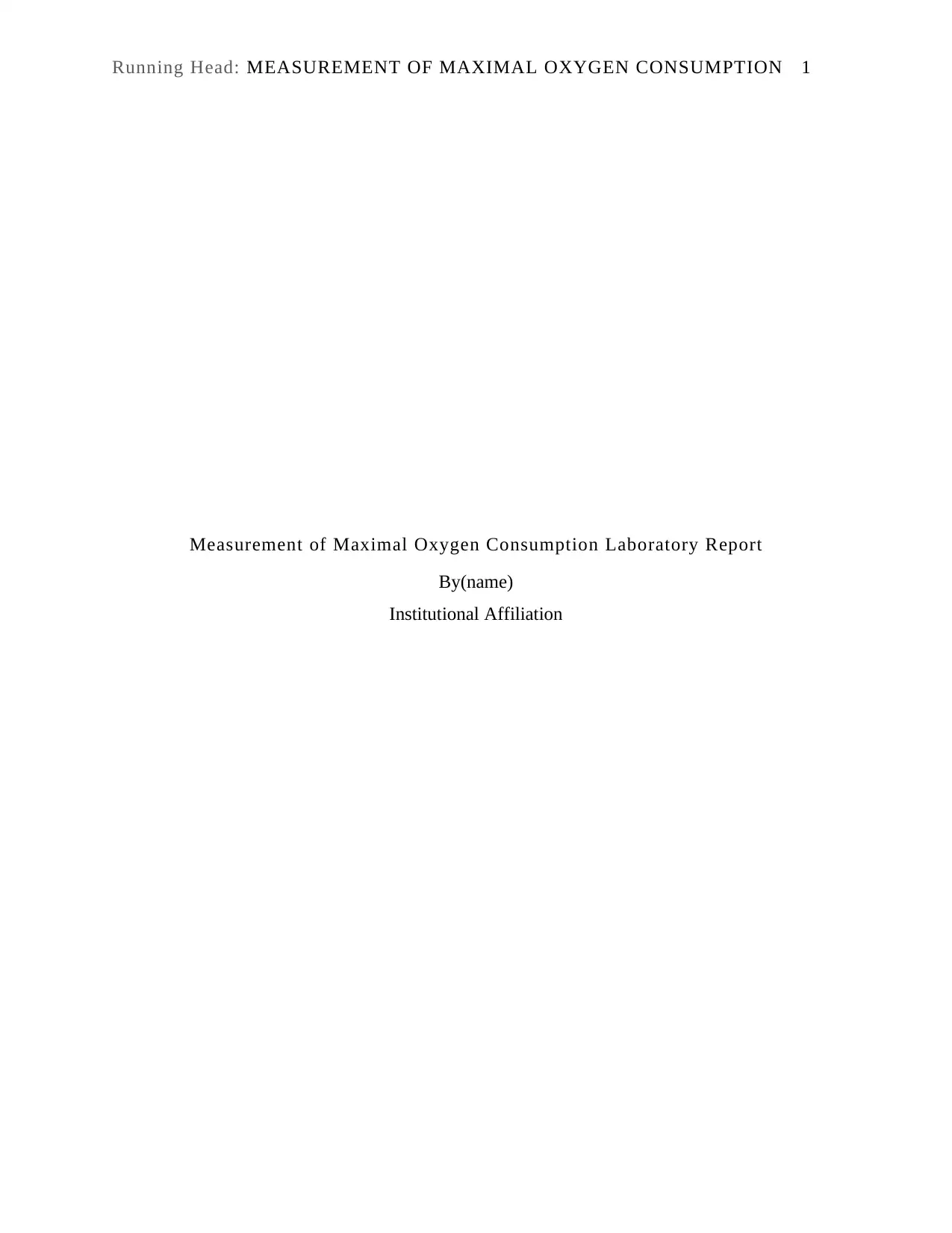
Running Head: MEASUREMENT OF MAXIMAL OXYGEN CONSUMPTION 1
Measurement of Maximal Oxygen Consumption Laboratory Report
By(name)
Institutional Affiliation
Measurement of Maximal Oxygen Consumption Laboratory Report
By(name)
Institutional Affiliation
Paraphrase This Document
Need a fresh take? Get an instant paraphrase of this document with our AI Paraphraser
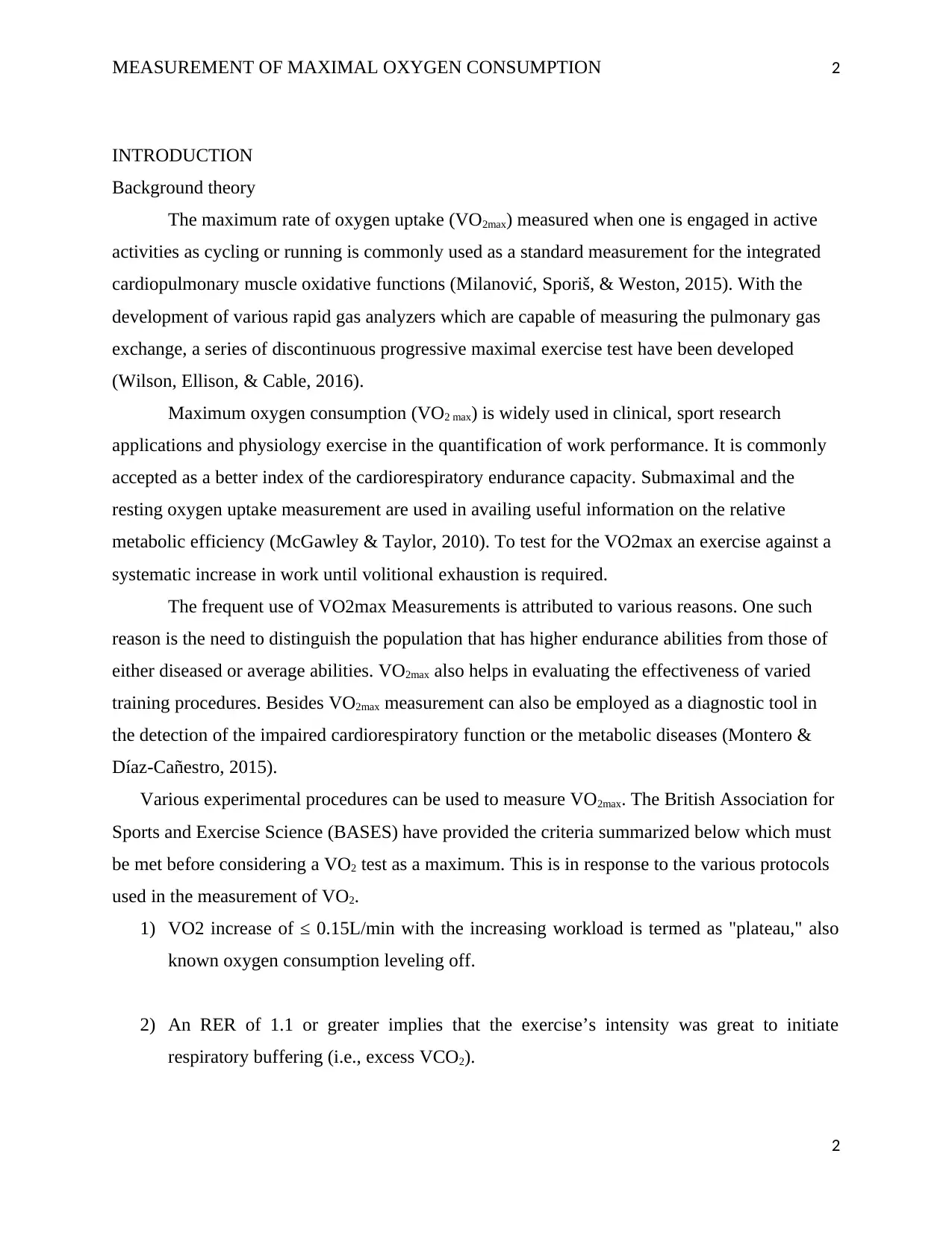
MEASUREMENT OF MAXIMAL OXYGEN CONSUMPTION 2
INTRODUCTION
Background theory
The maximum rate of oxygen uptake (VO2max) measured when one is engaged in active
activities as cycling or running is commonly used as a standard measurement for the integrated
cardiopulmonary muscle oxidative functions (Milanović, Sporiš, & Weston, 2015). With the
development of various rapid gas analyzers which are capable of measuring the pulmonary gas
exchange, a series of discontinuous progressive maximal exercise test have been developed
(Wilson, Ellison, & Cable, 2016).
Maximum oxygen consumption (VO2 max) is widely used in clinical, sport research
applications and physiology exercise in the quantification of work performance. It is commonly
accepted as a better index of the cardiorespiratory endurance capacity. Submaximal and the
resting oxygen uptake measurement are used in availing useful information on the relative
metabolic efficiency (McGawley & Taylor, 2010). To test for the VO2max an exercise against a
systematic increase in work until volitional exhaustion is required.
The frequent use of VO2max Measurements is attributed to various reasons. One such
reason is the need to distinguish the population that has higher endurance abilities from those of
either diseased or average abilities. VO2max also helps in evaluating the effectiveness of varied
training procedures. Besides VO2max measurement can also be employed as a diagnostic tool in
the detection of the impaired cardiorespiratory function or the metabolic diseases (Montero &
Díaz-Cañestro, 2015).
Various experimental procedures can be used to measure VO2max. The British Association for
Sports and Exercise Science (BASES) have provided the criteria summarized below which must
be met before considering a VO2 test as a maximum. This is in response to the various protocols
used in the measurement of VO2.
1) VO2 increase of ≤ 0.15L/min with the increasing workload is termed as "plateau," also
known oxygen consumption leveling off.
2) An RER of 1.1 or greater implies that the exercise’s intensity was great to initiate
respiratory buffering (i.e., excess VCO2).
2
INTRODUCTION
Background theory
The maximum rate of oxygen uptake (VO2max) measured when one is engaged in active
activities as cycling or running is commonly used as a standard measurement for the integrated
cardiopulmonary muscle oxidative functions (Milanović, Sporiš, & Weston, 2015). With the
development of various rapid gas analyzers which are capable of measuring the pulmonary gas
exchange, a series of discontinuous progressive maximal exercise test have been developed
(Wilson, Ellison, & Cable, 2016).
Maximum oxygen consumption (VO2 max) is widely used in clinical, sport research
applications and physiology exercise in the quantification of work performance. It is commonly
accepted as a better index of the cardiorespiratory endurance capacity. Submaximal and the
resting oxygen uptake measurement are used in availing useful information on the relative
metabolic efficiency (McGawley & Taylor, 2010). To test for the VO2max an exercise against a
systematic increase in work until volitional exhaustion is required.
The frequent use of VO2max Measurements is attributed to various reasons. One such
reason is the need to distinguish the population that has higher endurance abilities from those of
either diseased or average abilities. VO2max also helps in evaluating the effectiveness of varied
training procedures. Besides VO2max measurement can also be employed as a diagnostic tool in
the detection of the impaired cardiorespiratory function or the metabolic diseases (Montero &
Díaz-Cañestro, 2015).
Various experimental procedures can be used to measure VO2max. The British Association for
Sports and Exercise Science (BASES) have provided the criteria summarized below which must
be met before considering a VO2 test as a maximum. This is in response to the various protocols
used in the measurement of VO2.
1) VO2 increase of ≤ 0.15L/min with the increasing workload is termed as "plateau," also
known oxygen consumption leveling off.
2) An RER of 1.1 or greater implies that the exercise’s intensity was great to initiate
respiratory buffering (i.e., excess VCO2).
2

MEASUREMENT OF MAXIMAL OXYGEN CONSUMPTION 3
3) Plasma lactate concentration of ≥ 8.0 mmol/L. Also demonstrates the sufficiency of
exercise intensity. This too is used to explain that the exercise was of sufficient intensity
Resting blood lactate is around 1mmol/L
4) Attainment of age-predicted HRmax (i.e., 220 – age) within 10 beats/min.
5) An RPE ≥18. It indicates the participants “felt” they were close to their maximum
possible effort.
In the measurement of oxygen uptake, two critical parameters are required.
The minute ventilation (VE)=the amount of expired air per minute.
The concentration of oxygen and carbon IV oxide (VO2 and VCO2) of the expired gas.
Conversion of VE(ATPS) to VE(STPD)
VE(STPD) = [(VE (ATPS / collection time) x 60] x correction factor
Where correction factor is the intersection between the room temperature and the barometric
pressure.
In the analysis of Douglas bags, the proportion of oxygen that is contained in the exhaled gas is
recorded. When expressed as a decimal, it is referred to as the fraction of expired oxygen (FEO2).
The difference between these two values is the fraction of oxygen that is consumed (F1O2-
FEO2). Once the fraction of oxygen O2 used is computed, it is multiplied by VE to obtain the
volume of oxygen that is expired in the air (FEO2)
Equation 2: Calculation of O2
VO2 = VE x (FIO2 - FEO2)
VO2 = VE(STPD) (l/min) x (0.2093 - FEO2)
Aims
1. To refresh testing skills learned in previous laboratories.
3
3) Plasma lactate concentration of ≥ 8.0 mmol/L. Also demonstrates the sufficiency of
exercise intensity. This too is used to explain that the exercise was of sufficient intensity
Resting blood lactate is around 1mmol/L
4) Attainment of age-predicted HRmax (i.e., 220 – age) within 10 beats/min.
5) An RPE ≥18. It indicates the participants “felt” they were close to their maximum
possible effort.
In the measurement of oxygen uptake, two critical parameters are required.
The minute ventilation (VE)=the amount of expired air per minute.
The concentration of oxygen and carbon IV oxide (VO2 and VCO2) of the expired gas.
Conversion of VE(ATPS) to VE(STPD)
VE(STPD) = [(VE (ATPS / collection time) x 60] x correction factor
Where correction factor is the intersection between the room temperature and the barometric
pressure.
In the analysis of Douglas bags, the proportion of oxygen that is contained in the exhaled gas is
recorded. When expressed as a decimal, it is referred to as the fraction of expired oxygen (FEO2).
The difference between these two values is the fraction of oxygen that is consumed (F1O2-
FEO2). Once the fraction of oxygen O2 used is computed, it is multiplied by VE to obtain the
volume of oxygen that is expired in the air (FEO2)
Equation 2: Calculation of O2
VO2 = VE x (FIO2 - FEO2)
VO2 = VE(STPD) (l/min) x (0.2093 - FEO2)
Aims
1. To refresh testing skills learned in previous laboratories.
3
⊘ This is a preview!⊘
Do you want full access?
Subscribe today to unlock all pages.

Trusted by 1+ million students worldwide
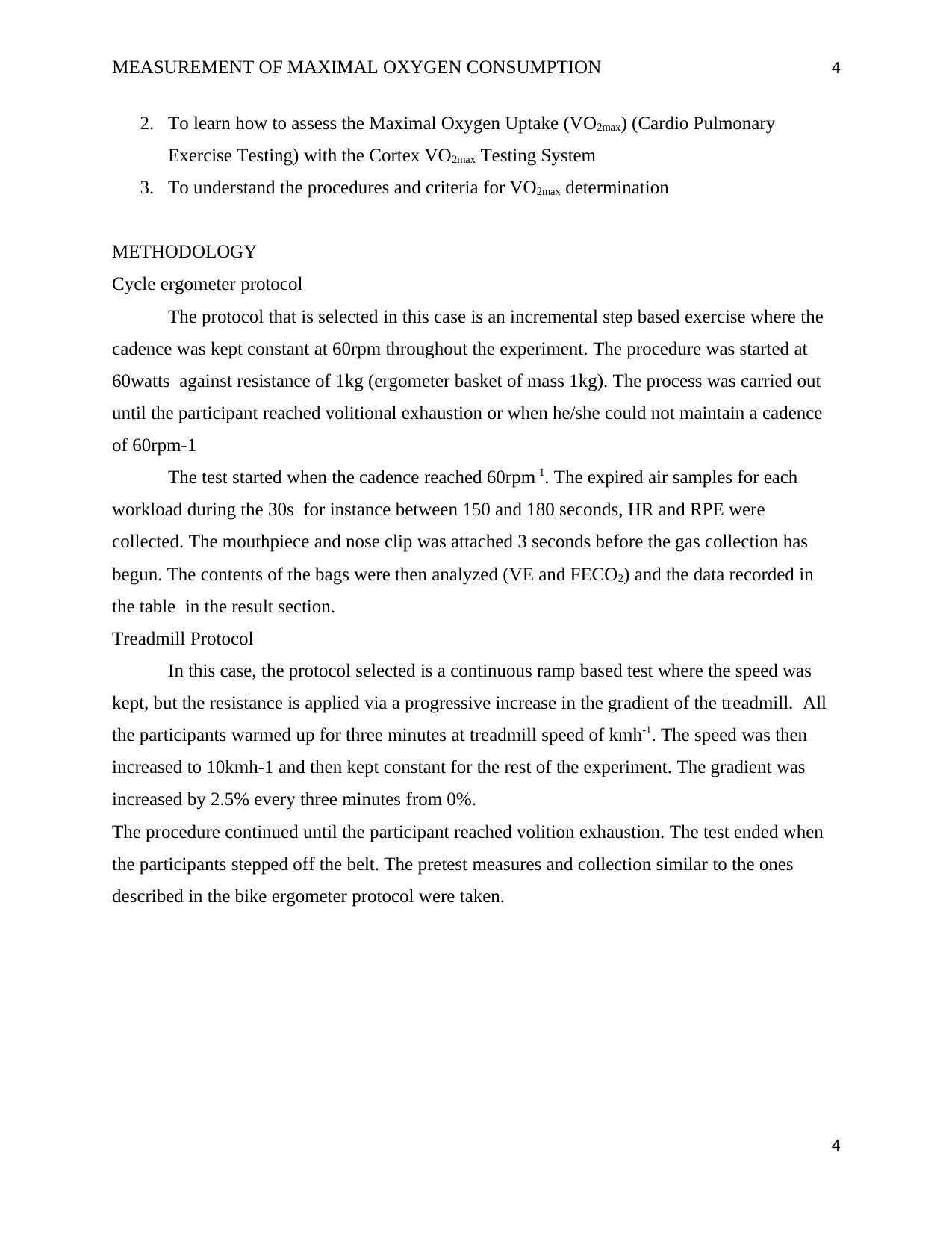
MEASUREMENT OF MAXIMAL OXYGEN CONSUMPTION 4
2. To learn how to assess the Maximal Oxygen Uptake (VO2max) (Cardio Pulmonary
Exercise Testing) with the Cortex VO2max Testing System
3. To understand the procedures and criteria for VO2max determination
METHODOLOGY
Cycle ergometer protocol
The protocol that is selected in this case is an incremental step based exercise where the
cadence was kept constant at 60rpm throughout the experiment. The procedure was started at
60watts against resistance of 1kg (ergometer basket of mass 1kg). The process was carried out
until the participant reached volitional exhaustion or when he/she could not maintain a cadence
of 60rpm-1
The test started when the cadence reached 60rpm-1. The expired air samples for each
workload during the 30s for instance between 150 and 180 seconds, HR and RPE were
collected. The mouthpiece and nose clip was attached 3 seconds before the gas collection has
begun. The contents of the bags were then analyzed (VE and FECO2) and the data recorded in
the table in the result section.
Treadmill Protocol
In this case, the protocol selected is a continuous ramp based test where the speed was
kept, but the resistance is applied via a progressive increase in the gradient of the treadmill. All
the participants warmed up for three minutes at treadmill speed of kmh-1. The speed was then
increased to 10kmh-1 and then kept constant for the rest of the experiment. The gradient was
increased by 2.5% every three minutes from 0%.
The procedure continued until the participant reached volition exhaustion. The test ended when
the participants stepped off the belt. The pretest measures and collection similar to the ones
described in the bike ergometer protocol were taken.
4
2. To learn how to assess the Maximal Oxygen Uptake (VO2max) (Cardio Pulmonary
Exercise Testing) with the Cortex VO2max Testing System
3. To understand the procedures and criteria for VO2max determination
METHODOLOGY
Cycle ergometer protocol
The protocol that is selected in this case is an incremental step based exercise where the
cadence was kept constant at 60rpm throughout the experiment. The procedure was started at
60watts against resistance of 1kg (ergometer basket of mass 1kg). The process was carried out
until the participant reached volitional exhaustion or when he/she could not maintain a cadence
of 60rpm-1
The test started when the cadence reached 60rpm-1. The expired air samples for each
workload during the 30s for instance between 150 and 180 seconds, HR and RPE were
collected. The mouthpiece and nose clip was attached 3 seconds before the gas collection has
begun. The contents of the bags were then analyzed (VE and FECO2) and the data recorded in
the table in the result section.
Treadmill Protocol
In this case, the protocol selected is a continuous ramp based test where the speed was
kept, but the resistance is applied via a progressive increase in the gradient of the treadmill. All
the participants warmed up for three minutes at treadmill speed of kmh-1. The speed was then
increased to 10kmh-1 and then kept constant for the rest of the experiment. The gradient was
increased by 2.5% every three minutes from 0%.
The procedure continued until the participant reached volition exhaustion. The test ended when
the participants stepped off the belt. The pretest measures and collection similar to the ones
described in the bike ergometer protocol were taken.
4
Paraphrase This Document
Need a fresh take? Get an instant paraphrase of this document with our AI Paraphraser
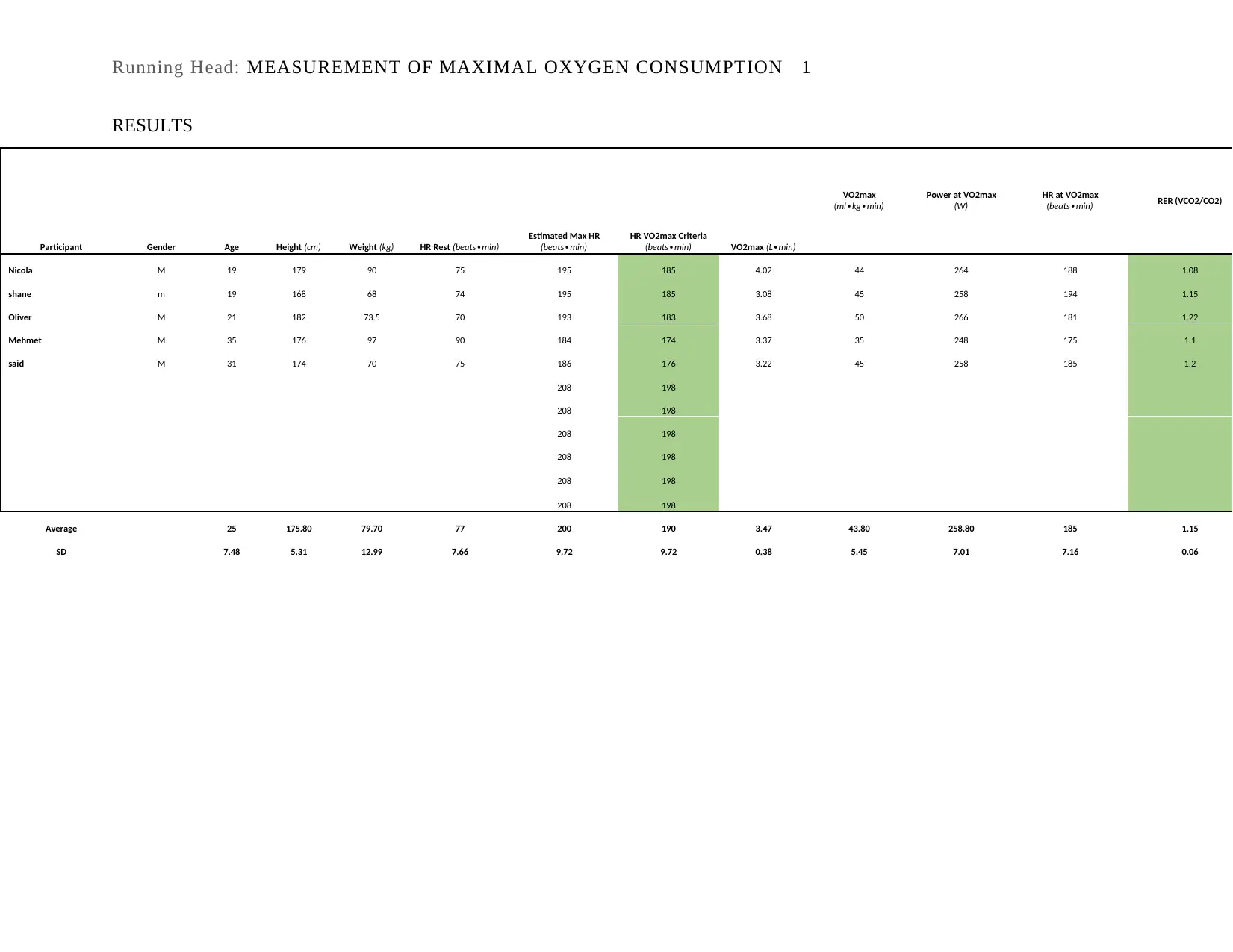
Running Head: MEASUREMENT OF MAXIMAL OXYGEN CONSUMPTION 1
RESULTS
Participant Gender Age Height (cm) Weight (kg) HR Rest (beats min)∙
Estimated Max HR
(beats min)∙
HR VO2max Criteria
(beats min)∙ VO2max (L min)∙
VO2max
(ml kg min)∙ ∙
Power at VO2max
(W)
HR at VO2max
(beats min)∙ RER (VCO2/CO2)
Nicola M 19 179 90 75 195 185 4.02 44 264 188 1.08
shane m 19 168 68 74 195 185 3.08 45 258 194 1.15
Oliver M 21 182 73.5 70 193 183 3.68 50 266 181 1.22
Mehmet M 35 176 97 90 184 174 3.37 35 248 175 1.1
said M 31 174 70 75 186 176 3.22 45 258 185 1.2
208 198
208 198
208 198
208 198
208 198
208 198
Average 25 175.80 79.70 77 200 190 3.47 43.80 258.80 185 1.15
SD 7.48 5.31 12.99 7.66 9.72 9.72 0.38 5.45 7.01 7.16 0.06
RESULTS
Participant Gender Age Height (cm) Weight (kg) HR Rest (beats min)∙
Estimated Max HR
(beats min)∙
HR VO2max Criteria
(beats min)∙ VO2max (L min)∙
VO2max
(ml kg min)∙ ∙
Power at VO2max
(W)
HR at VO2max
(beats min)∙ RER (VCO2/CO2)
Nicola M 19 179 90 75 195 185 4.02 44 264 188 1.08
shane m 19 168 68 74 195 185 3.08 45 258 194 1.15
Oliver M 21 182 73.5 70 193 183 3.68 50 266 181 1.22
Mehmet M 35 176 97 90 184 174 3.37 35 248 175 1.1
said M 31 174 70 75 186 176 3.22 45 258 185 1.2
208 198
208 198
208 198
208 198
208 198
208 198
Average 25 175.80 79.70 77 200 190 3.47 43.80 258.80 185 1.15
SD 7.48 5.31 12.99 7.66 9.72 9.72 0.38 5.45 7.01 7.16 0.06
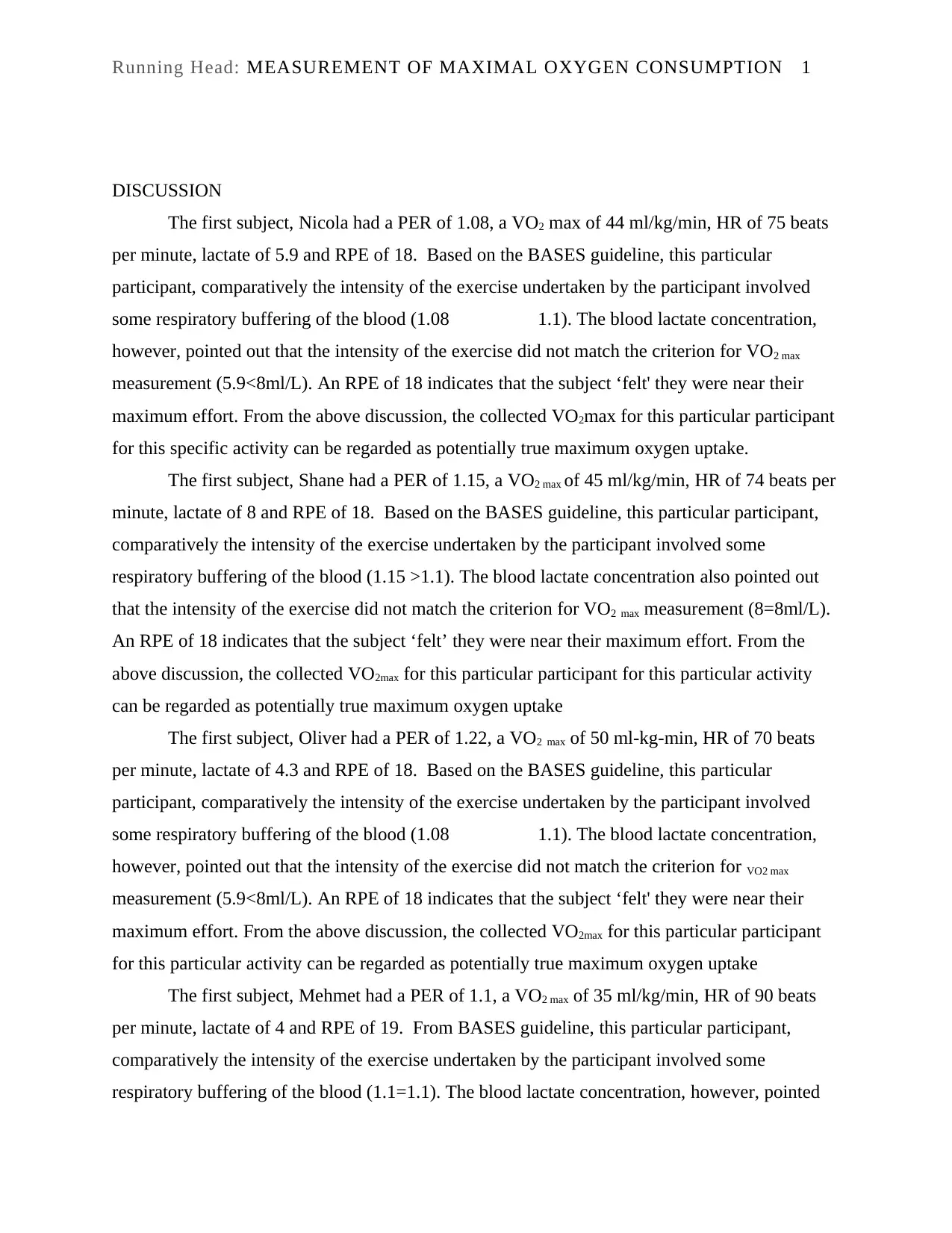
Running Head: MEASUREMENT OF MAXIMAL OXYGEN CONSUMPTION 1
DISCUSSION
The first subject, Nicola had a PER of 1.08, a VO2 max of 44 ml/kg/min, HR of 75 beats
per minute, lactate of 5.9 and RPE of 18. Based on the BASES guideline, this particular
participant, comparatively the intensity of the exercise undertaken by the participant involved
some respiratory buffering of the blood (1.08 1.1). The blood lactate concentration,
however, pointed out that the intensity of the exercise did not match the criterion for VO2 max
measurement (5.9<8ml/L). An RPE of 18 indicates that the subject ‘felt' they were near their
maximum effort. From the above discussion, the collected VO2max for this particular participant
for this specific activity can be regarded as potentially true maximum oxygen uptake.
The first subject, Shane had a PER of 1.15, a VO2 max of 45 ml/kg/min, HR of 74 beats per
minute, lactate of 8 and RPE of 18. Based on the BASES guideline, this particular participant,
comparatively the intensity of the exercise undertaken by the participant involved some
respiratory buffering of the blood (1.15 >1.1). The blood lactate concentration also pointed out
that the intensity of the exercise did not match the criterion for VO2 max measurement (8=8ml/L).
An RPE of 18 indicates that the subject ‘felt’ they were near their maximum effort. From the
above discussion, the collected VO2max for this particular participant for this particular activity
can be regarded as potentially true maximum oxygen uptake
The first subject, Oliver had a PER of 1.22, a VO2 max of 50 ml-kg-min, HR of 70 beats
per minute, lactate of 4.3 and RPE of 18. Based on the BASES guideline, this particular
participant, comparatively the intensity of the exercise undertaken by the participant involved
some respiratory buffering of the blood (1.08 1.1). The blood lactate concentration,
however, pointed out that the intensity of the exercise did not match the criterion for VO2 max
measurement (5.9<8ml/L). An RPE of 18 indicates that the subject ‘felt' they were near their
maximum effort. From the above discussion, the collected VO2max for this particular participant
for this particular activity can be regarded as potentially true maximum oxygen uptake
The first subject, Mehmet had a PER of 1.1, a VO2 max of 35 ml/kg/min, HR of 90 beats
per minute, lactate of 4 and RPE of 19. From BASES guideline, this particular participant,
comparatively the intensity of the exercise undertaken by the participant involved some
respiratory buffering of the blood (1.1=1.1). The blood lactate concentration, however, pointed
DISCUSSION
The first subject, Nicola had a PER of 1.08, a VO2 max of 44 ml/kg/min, HR of 75 beats
per minute, lactate of 5.9 and RPE of 18. Based on the BASES guideline, this particular
participant, comparatively the intensity of the exercise undertaken by the participant involved
some respiratory buffering of the blood (1.08 1.1). The blood lactate concentration,
however, pointed out that the intensity of the exercise did not match the criterion for VO2 max
measurement (5.9<8ml/L). An RPE of 18 indicates that the subject ‘felt' they were near their
maximum effort. From the above discussion, the collected VO2max for this particular participant
for this specific activity can be regarded as potentially true maximum oxygen uptake.
The first subject, Shane had a PER of 1.15, a VO2 max of 45 ml/kg/min, HR of 74 beats per
minute, lactate of 8 and RPE of 18. Based on the BASES guideline, this particular participant,
comparatively the intensity of the exercise undertaken by the participant involved some
respiratory buffering of the blood (1.15 >1.1). The blood lactate concentration also pointed out
that the intensity of the exercise did not match the criterion for VO2 max measurement (8=8ml/L).
An RPE of 18 indicates that the subject ‘felt’ they were near their maximum effort. From the
above discussion, the collected VO2max for this particular participant for this particular activity
can be regarded as potentially true maximum oxygen uptake
The first subject, Oliver had a PER of 1.22, a VO2 max of 50 ml-kg-min, HR of 70 beats
per minute, lactate of 4.3 and RPE of 18. Based on the BASES guideline, this particular
participant, comparatively the intensity of the exercise undertaken by the participant involved
some respiratory buffering of the blood (1.08 1.1). The blood lactate concentration,
however, pointed out that the intensity of the exercise did not match the criterion for VO2 max
measurement (5.9<8ml/L). An RPE of 18 indicates that the subject ‘felt' they were near their
maximum effort. From the above discussion, the collected VO2max for this particular participant
for this particular activity can be regarded as potentially true maximum oxygen uptake
The first subject, Mehmet had a PER of 1.1, a VO2 max of 35 ml/kg/min, HR of 90 beats
per minute, lactate of 4 and RPE of 19. From BASES guideline, this particular participant,
comparatively the intensity of the exercise undertaken by the participant involved some
respiratory buffering of the blood (1.1=1.1). The blood lactate concentration, however, pointed
⊘ This is a preview!⊘
Do you want full access?
Subscribe today to unlock all pages.

Trusted by 1+ million students worldwide
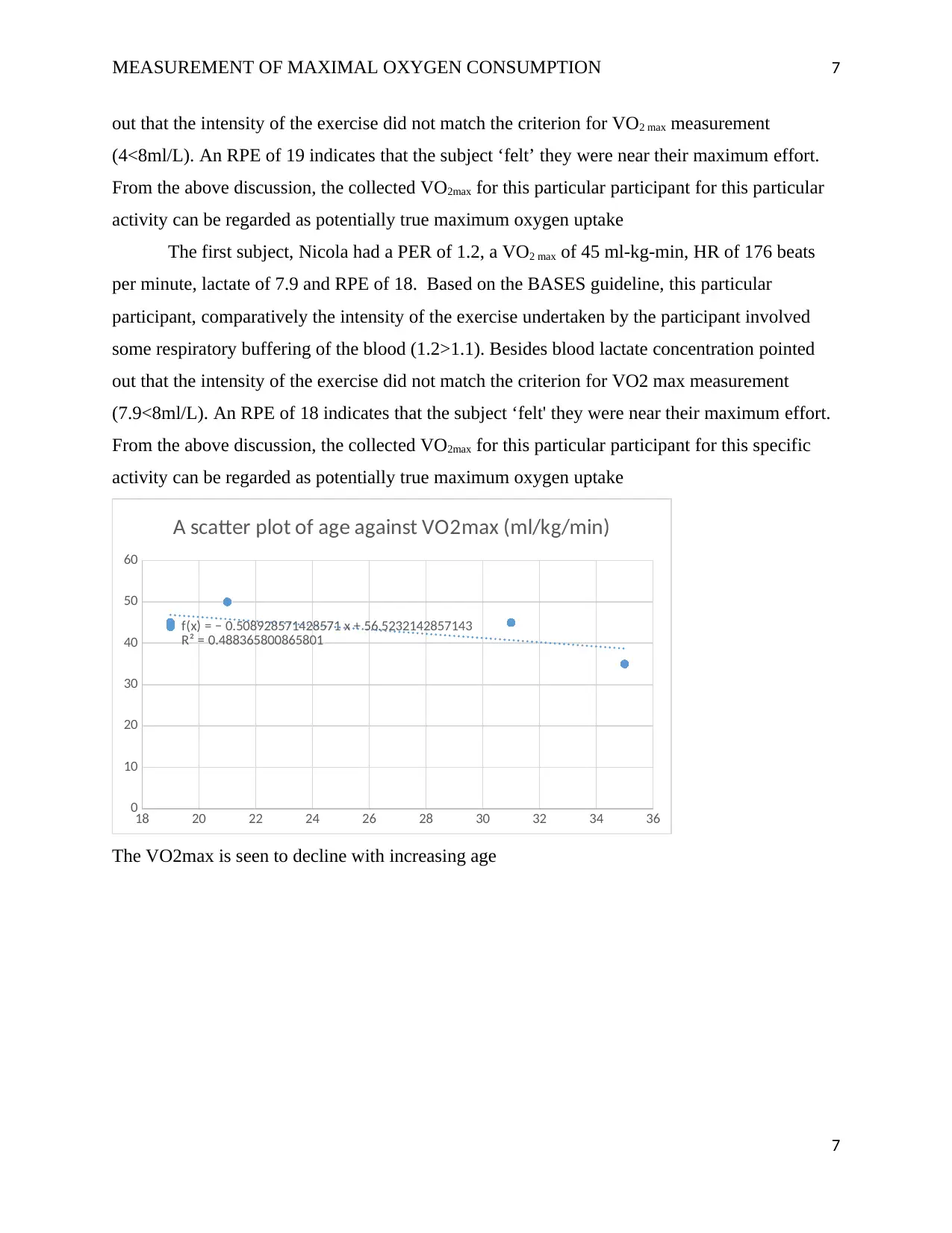
MEASUREMENT OF MAXIMAL OXYGEN CONSUMPTION 7
out that the intensity of the exercise did not match the criterion for VO2 max measurement
(4<8ml/L). An RPE of 19 indicates that the subject ‘felt’ they were near their maximum effort.
From the above discussion, the collected VO2max for this particular participant for this particular
activity can be regarded as potentially true maximum oxygen uptake
The first subject, Nicola had a PER of 1.2, a VO2 max of 45 ml-kg-min, HR of 176 beats
per minute, lactate of 7.9 and RPE of 18. Based on the BASES guideline, this particular
participant, comparatively the intensity of the exercise undertaken by the participant involved
some respiratory buffering of the blood (1.2>1.1). Besides blood lactate concentration pointed
out that the intensity of the exercise did not match the criterion for VO2 max measurement
(7.9<8ml/L). An RPE of 18 indicates that the subject ‘felt' they were near their maximum effort.
From the above discussion, the collected VO2max for this particular participant for this specific
activity can be regarded as potentially true maximum oxygen uptake
18 20 22 24 26 28 30 32 34 36
0
10
20
30
40
50
60
f(x) = − 0.508928571428571 x + 56.5232142857143
R² = 0.488365800865801
A scatter plot of age against VO2max (ml/kg/min)
The VO2max is seen to decline with increasing age
7
out that the intensity of the exercise did not match the criterion for VO2 max measurement
(4<8ml/L). An RPE of 19 indicates that the subject ‘felt’ they were near their maximum effort.
From the above discussion, the collected VO2max for this particular participant for this particular
activity can be regarded as potentially true maximum oxygen uptake
The first subject, Nicola had a PER of 1.2, a VO2 max of 45 ml-kg-min, HR of 176 beats
per minute, lactate of 7.9 and RPE of 18. Based on the BASES guideline, this particular
participant, comparatively the intensity of the exercise undertaken by the participant involved
some respiratory buffering of the blood (1.2>1.1). Besides blood lactate concentration pointed
out that the intensity of the exercise did not match the criterion for VO2 max measurement
(7.9<8ml/L). An RPE of 18 indicates that the subject ‘felt' they were near their maximum effort.
From the above discussion, the collected VO2max for this particular participant for this specific
activity can be regarded as potentially true maximum oxygen uptake
18 20 22 24 26 28 30 32 34 36
0
10
20
30
40
50
60
f(x) = − 0.508928571428571 x + 56.5232142857143
R² = 0.488365800865801
A scatter plot of age against VO2max (ml/kg/min)
The VO2max is seen to decline with increasing age
7
Paraphrase This Document
Need a fresh take? Get an instant paraphrase of this document with our AI Paraphraser

MEASUREMENT OF MAXIMAL OXYGEN CONSUMPTION 8
18 20 22 24 26 28 30 32 34 36
0
10
20
30
40
50
60
f(x) = − 0.508928571428571 x + 56.5232142857143
R² = 0.488365800865801
A scatter plot of age against VO2max (ml/kg/min)
The scatter plot above shows that VO2max is more significant among small-sized
participants.
From the experiment, the average VO2 max for the six participants was 43.80 ml-kg-min. From the
literature, the average normal VO2max for a typical college age male has an absolute value of 45-
50mL/kg/min for active student and relative importance of 0.47-0.53(compared to the maximum
amount of 95ml/kg/min (Tønnessen, Haugen, Hem, Leirstein, & Seiler, 2015). The experimental
value obtained compares significantly with these values
There is a possibility of calibration related errors which might have yielded faulty results
The linearity of the gas analyzer. No gas is analyzer is entirely linear. The analyzed
values were based on this assumption.
There was a possibility of improperly calibrating the gas connection.
Problems with the ambient gas concentration for example particularly for resting
metabolism.
Complications with the valves might have also resulted in erroneous volumes of gases
collected.
CONCLUSION
Throughout the session, VO2 uptake, a skill learned in the previous laboratory session
was revisited. Maximum oxygen uptake (VO2) max was assessed. The average maximum
absorption for the 6 participants was found to be 43.80 ml/kg/min. Maximum oxygen uptake was
8
18 20 22 24 26 28 30 32 34 36
0
10
20
30
40
50
60
f(x) = − 0.508928571428571 x + 56.5232142857143
R² = 0.488365800865801
A scatter plot of age against VO2max (ml/kg/min)
The scatter plot above shows that VO2max is more significant among small-sized
participants.
From the experiment, the average VO2 max for the six participants was 43.80 ml-kg-min. From the
literature, the average normal VO2max for a typical college age male has an absolute value of 45-
50mL/kg/min for active student and relative importance of 0.47-0.53(compared to the maximum
amount of 95ml/kg/min (Tønnessen, Haugen, Hem, Leirstein, & Seiler, 2015). The experimental
value obtained compares significantly with these values
There is a possibility of calibration related errors which might have yielded faulty results
The linearity of the gas analyzer. No gas is analyzer is entirely linear. The analyzed
values were based on this assumption.
There was a possibility of improperly calibrating the gas connection.
Problems with the ambient gas concentration for example particularly for resting
metabolism.
Complications with the valves might have also resulted in erroneous volumes of gases
collected.
CONCLUSION
Throughout the session, VO2 uptake, a skill learned in the previous laboratory session
was revisited. Maximum oxygen uptake (VO2) max was assessed. The average maximum
absorption for the 6 participants was found to be 43.80 ml/kg/min. Maximum oxygen uptake was
8
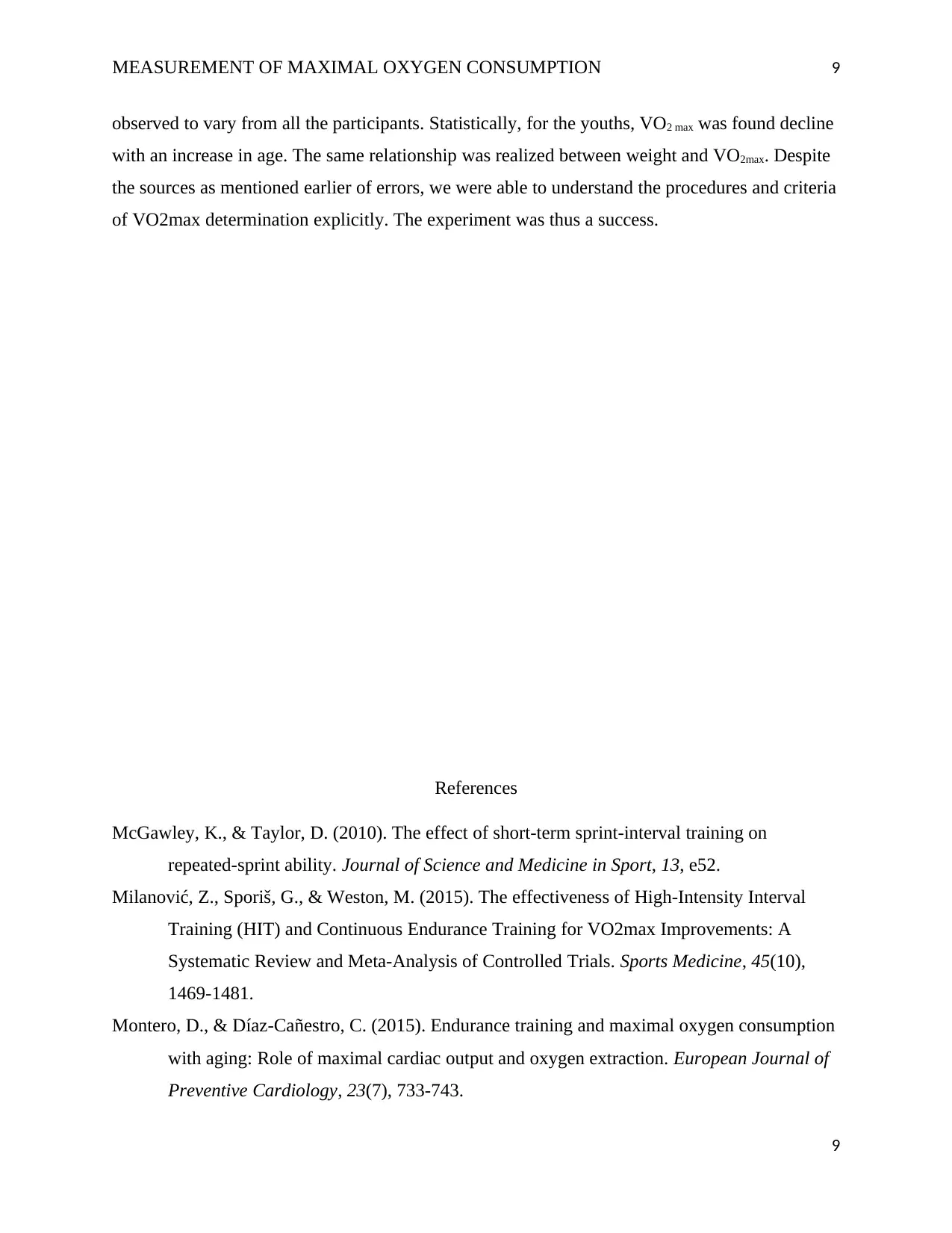
MEASUREMENT OF MAXIMAL OXYGEN CONSUMPTION 9
observed to vary from all the participants. Statistically, for the youths, VO2 max was found decline
with an increase in age. The same relationship was realized between weight and VO2max. Despite
the sources as mentioned earlier of errors, we were able to understand the procedures and criteria
of VO2max determination explicitly. The experiment was thus a success.
References
McGawley, K., & Taylor, D. (2010). The effect of short-term sprint-interval training on
repeated-sprint ability. Journal of Science and Medicine in Sport, 13, e52.
Milanović, Z., Sporiš, G., & Weston, M. (2015). The effectiveness of High-Intensity Interval
Training (HIT) and Continuous Endurance Training for VO2max Improvements: A
Systematic Review and Meta-Analysis of Controlled Trials. Sports Medicine, 45(10),
1469-1481.
Montero, D., & Díaz-Cañestro, C. (2015). Endurance training and maximal oxygen consumption
with aging: Role of maximal cardiac output and oxygen extraction. European Journal of
Preventive Cardiology, 23(7), 733-743.
9
observed to vary from all the participants. Statistically, for the youths, VO2 max was found decline
with an increase in age. The same relationship was realized between weight and VO2max. Despite
the sources as mentioned earlier of errors, we were able to understand the procedures and criteria
of VO2max determination explicitly. The experiment was thus a success.
References
McGawley, K., & Taylor, D. (2010). The effect of short-term sprint-interval training on
repeated-sprint ability. Journal of Science and Medicine in Sport, 13, e52.
Milanović, Z., Sporiš, G., & Weston, M. (2015). The effectiveness of High-Intensity Interval
Training (HIT) and Continuous Endurance Training for VO2max Improvements: A
Systematic Review and Meta-Analysis of Controlled Trials. Sports Medicine, 45(10),
1469-1481.
Montero, D., & Díaz-Cañestro, C. (2015). Endurance training and maximal oxygen consumption
with aging: Role of maximal cardiac output and oxygen extraction. European Journal of
Preventive Cardiology, 23(7), 733-743.
9
⊘ This is a preview!⊘
Do you want full access?
Subscribe today to unlock all pages.

Trusted by 1+ million students worldwide
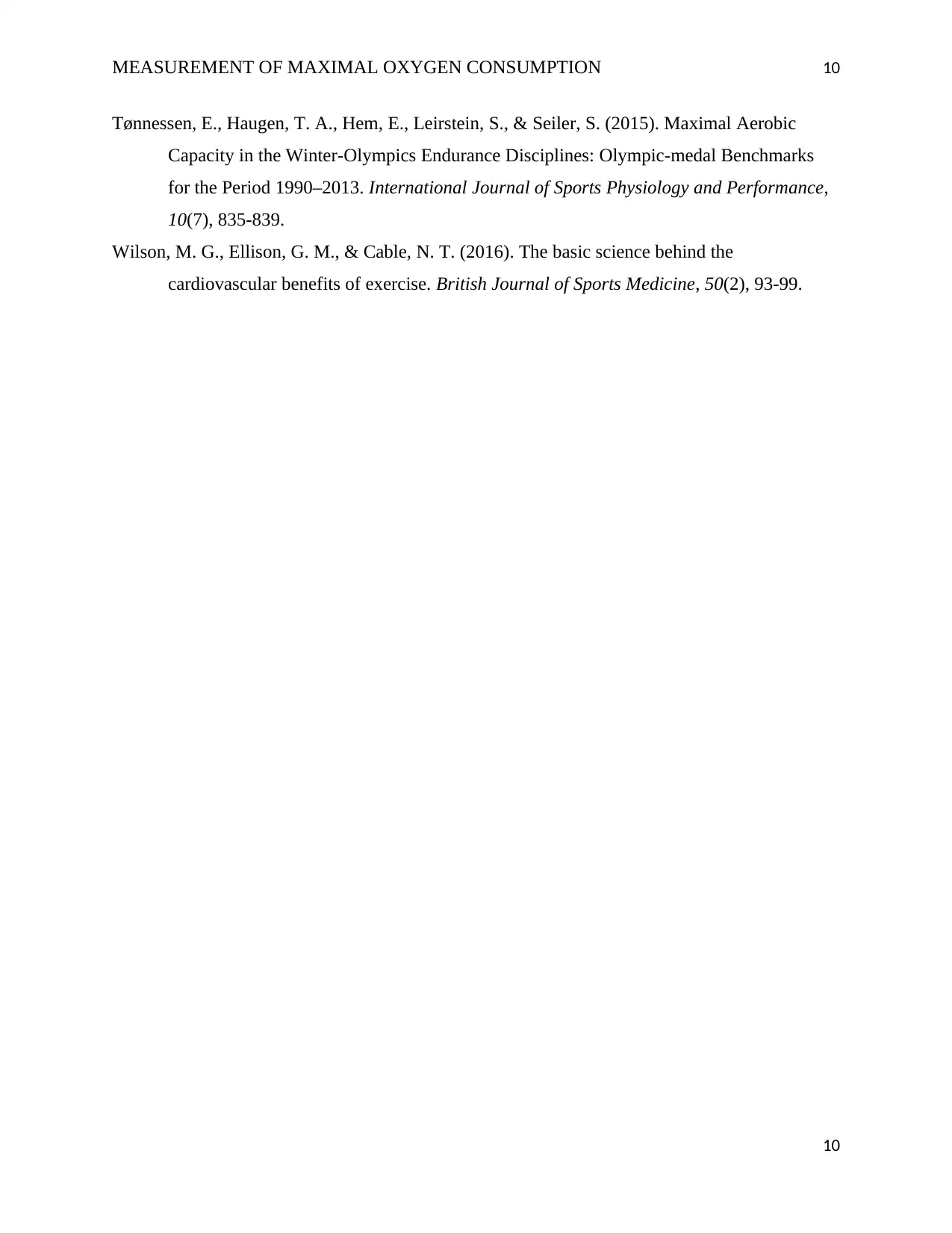
MEASUREMENT OF MAXIMAL OXYGEN CONSUMPTION 10
Tønnessen, E., Haugen, T. A., Hem, E., Leirstein, S., & Seiler, S. (2015). Maximal Aerobic
Capacity in the Winter-Olympics Endurance Disciplines: Olympic-medal Benchmarks
for the Period 1990–2013. International Journal of Sports Physiology and Performance,
10(7), 835-839.
Wilson, M. G., Ellison, G. M., & Cable, N. T. (2016). The basic science behind the
cardiovascular benefits of exercise. British Journal of Sports Medicine, 50(2), 93-99.
10
Tønnessen, E., Haugen, T. A., Hem, E., Leirstein, S., & Seiler, S. (2015). Maximal Aerobic
Capacity in the Winter-Olympics Endurance Disciplines: Olympic-medal Benchmarks
for the Period 1990–2013. International Journal of Sports Physiology and Performance,
10(7), 835-839.
Wilson, M. G., Ellison, G. M., & Cable, N. T. (2016). The basic science behind the
cardiovascular benefits of exercise. British Journal of Sports Medicine, 50(2), 93-99.
10
1 out of 10
Your All-in-One AI-Powered Toolkit for Academic Success.
+13062052269
info@desklib.com
Available 24*7 on WhatsApp / Email
![[object Object]](/_next/static/media/star-bottom.7253800d.svg)
Unlock your academic potential
Copyright © 2020–2025 A2Z Services. All Rights Reserved. Developed and managed by ZUCOL.


